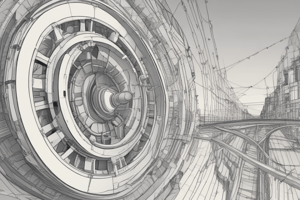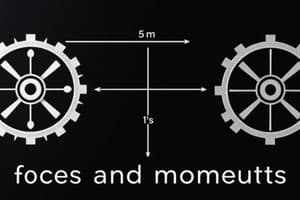Podcast
Questions and Answers
What is the definition of moment in the realm of engineering mechanics?
What is the definition of moment in the realm of engineering mechanics?
- The force's magnitude times the angle between the line of action and the axis of rotation.
- The product of the force's magnitude and the parallel distance from the line of action to the axis of rotation.
- The force's magnitude divided by the perpendicular distance from the line of action to the axis of rotation.
- The product of the force's magnitude and the perpendicular distance from the line of action to the axis of rotation. (correct)
How is the direction of a moment determined according to the text?
How is the direction of a moment determined according to the text?
- By pointing your fingers in the opposite direction of the axis of rotation.
- By using the right-hand rule: fingers curl in the direction of force, thumb points in the direction of moment. (correct)
- By using the left-hand rule.
- By aligning your body with the force's direction.
What are the typical units used to express moments in engineering mechanics?
What are the typical units used to express moments in engineering mechanics?
- Watt-seconds
- Meters per second squared
- Newton meters (Nm) or pound-feet (lb·ft) (correct)
- Kilograms per second
How can the moment of a force be calculated based on the provided text?
How can the moment of a force be calculated based on the provided text?
Which symbol is commonly used to represent moments?
Which symbol is commonly used to represent moments?
Why is understanding moments important in engineering mechanics according to the text?
Why is understanding moments important in engineering mechanics according to the text?
In static equilibrium, an object is considered balanced when ________________.
In static equilibrium, an object is considered balanced when ________________.
How do moments contribute to structural analysis in engineering applications?
How do moments contribute to structural analysis in engineering applications?
Which method is used to calculate the moment of a force about a different axis than the one used to calculate its original moment?
Which method is used to calculate the moment of a force about a different axis than the one used to calculate its original moment?
What misconception do people often have about moment and torque?
What misconception do people often have about moment and torque?
What type of moment results from a couple in engineering applications?
What type of moment results from a couple in engineering applications?
Why is understanding moment calculations essential for engineers in machine design?
Why is understanding moment calculations essential for engineers in machine design?
Flashcards are hidden until you start studying
Study Notes
Engineering Mechanics: Understanding Moment
Moment, in the realm of engineering mechanics, is a fundamental concept that helps us analyze the behavior of forces acting on objects, particularly in cases where forces create bending, twisting, or turning effects. To grasp the essence of moment and its significance, let's delve into its properties and applications.
Definition and Properties
The moment of a force is defined as the product of the magnitude of the force and the perpendicular distance between the line of action of the force and a chosen reference line, known as the "axis of rotation." The direction of the moment is determined by the right-hand rule, which states that if you place your right hand so that your fingers curl around the axis of rotation such that they point in the direction of the moment, then your thumb will point in the direction of the force.
Moments are typically represented by the symbol M or T, and their units are newton meters (Nm) or pound-feet (lb·ft). The moment of a force can be calculated using the equation:
(M = F \times d),
where F represents the force and d represents the perpendicular distance from the line of action of the force to the reference line.
Equilibrium and Moments
In the study of engineering mechanics, understanding moments plays a crucial role in determining whether an object is in equilibrium or not. According to the principle of moments, an object is in equilibrium when the sum of all clockwise moments is equal to the sum of all counterclockwise moments acting on the object. This principle is represented by the equation:
(\sum M_C = \sum M_C),
where the subscripts C and CC denote counterclockwise and clockwise moments, respectively.
Applications
Moment plays a key role in several engineering applications, including:
-
Structural analysis: Moments help calculate bending stresses and deformations of beams, trusses, and other structural components.
-
Machine design: Moments allow engineers to determine the forces acting on rotating components and their effect on the overall performance of the machine.
-
Static equilibrium: Moments help engineers determine whether a system is in equilibrium and find the necessary adjustments for stability.
-
Dynamic analysis: Moments are used to study the behavior of dynamic systems, such as rotating machinery or rotating fluid flow, where inertial and centrifugal forces come into play.
Moment Calculations
Moment calculations can be performed using various methods, such as:
-
Direct method: Calculating the moment of a force directly using the equation (M = F \times d).
-
Parallel-axis theorem: Used to calculate the moment of a force about a different axis than the one used to calculate its original moment.
-
Couple method: Used to calculate the moment of a force acting on a rigid body when the line of action of the force passes through the center of mass.
-
Distributing moments: Summing the moments of individual forces to find the resultant moment of a distributed force.
Common Misconceptions
-
Moment always results in torque: Moment and torque are not the same thing. Torque is a type of moment, specifically, the moment created by a couple, which consists of two forces acting in opposite directions and parallel to each other.
-
Moment always results in rotation: Moment doesn't always result in rotation. For example, the moment of a force acting on a cantilevered beam results in bending without rotation.
Understanding and applying moment concepts in engineering mechanics is essential for engineers and designers to analyze, design, and optimize various systems and structures. By mastering moment calculations and their applications, engineers can make informed decisions to ensure the safety, stability, and efficiency of engineering projects.
Studying That Suits You
Use AI to generate personalized quizzes and flashcards to suit your learning preferences.




